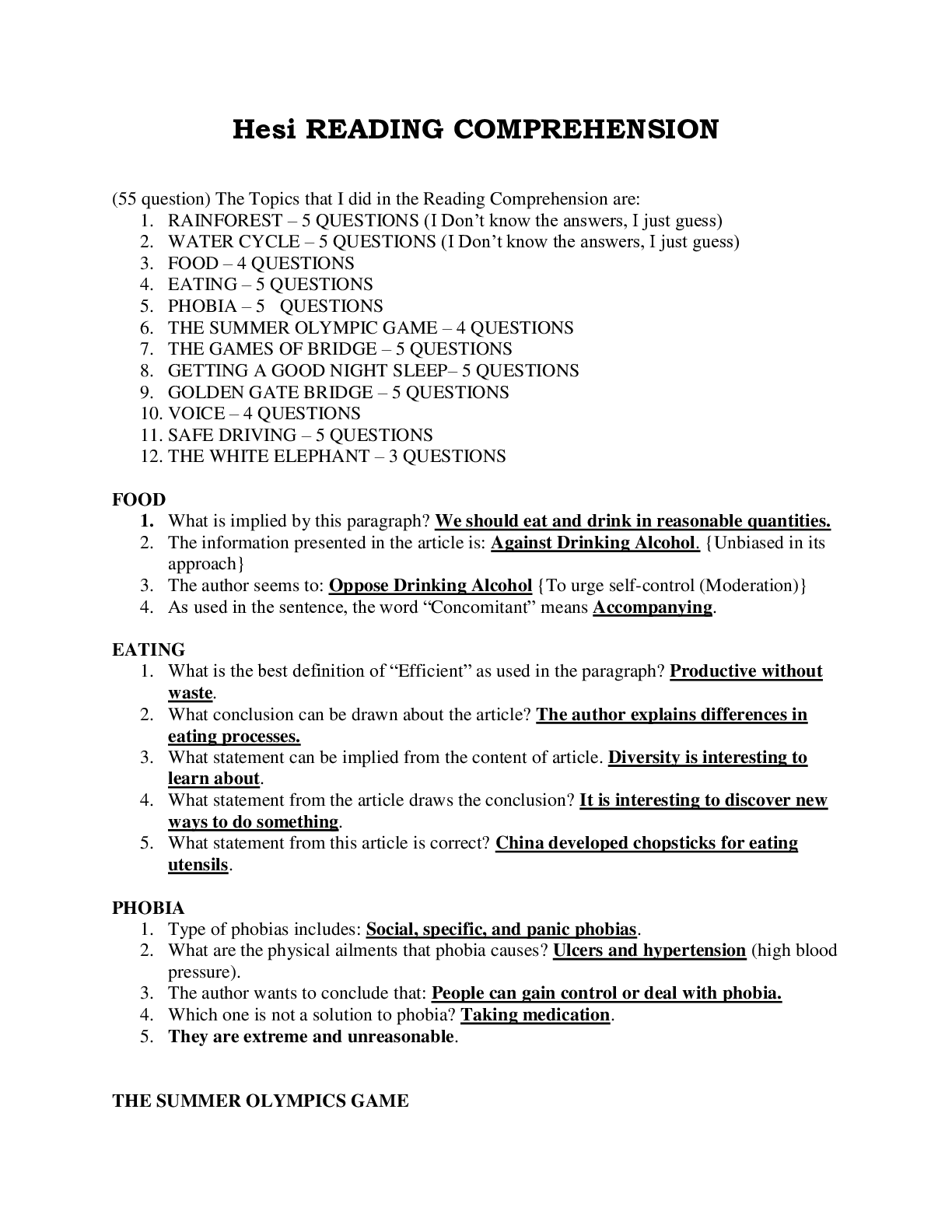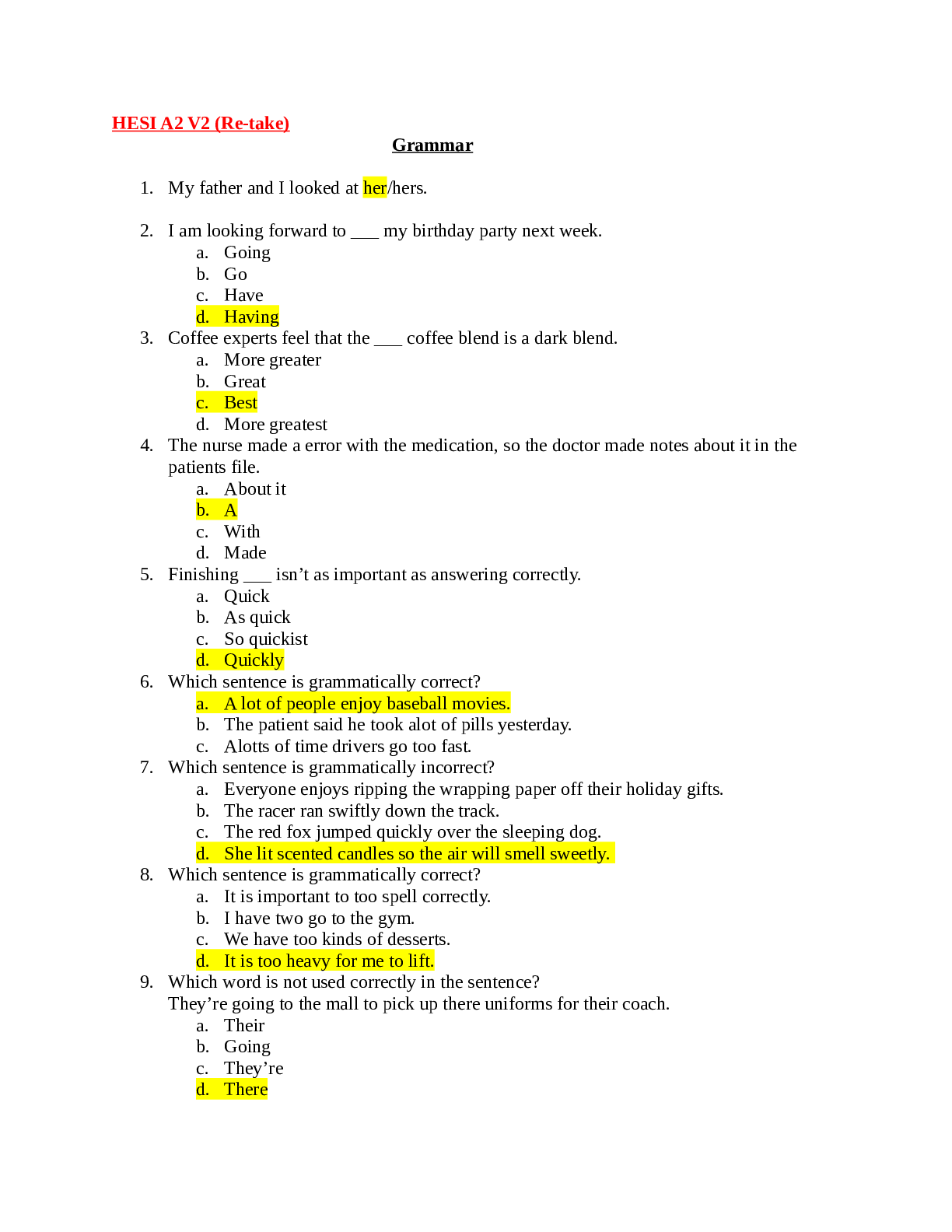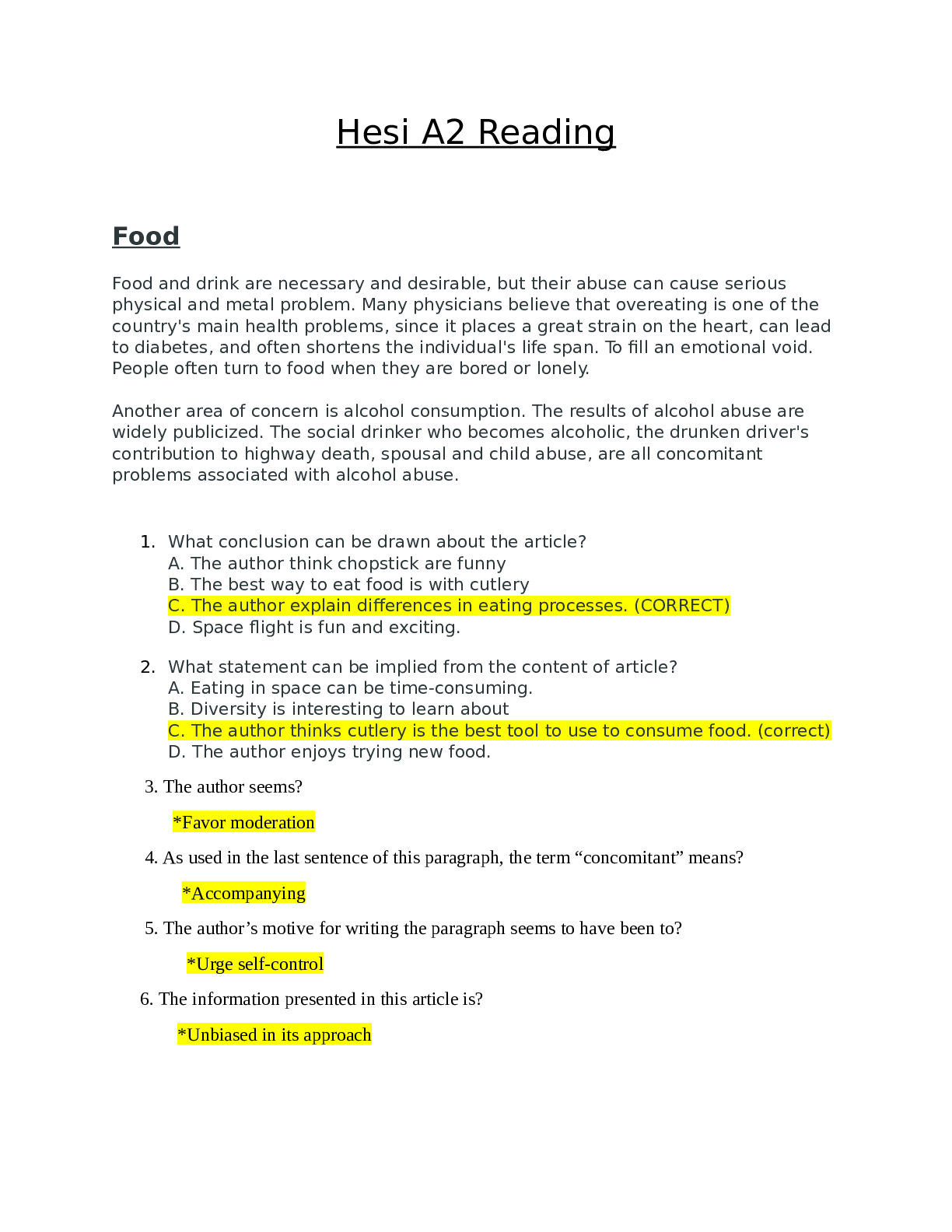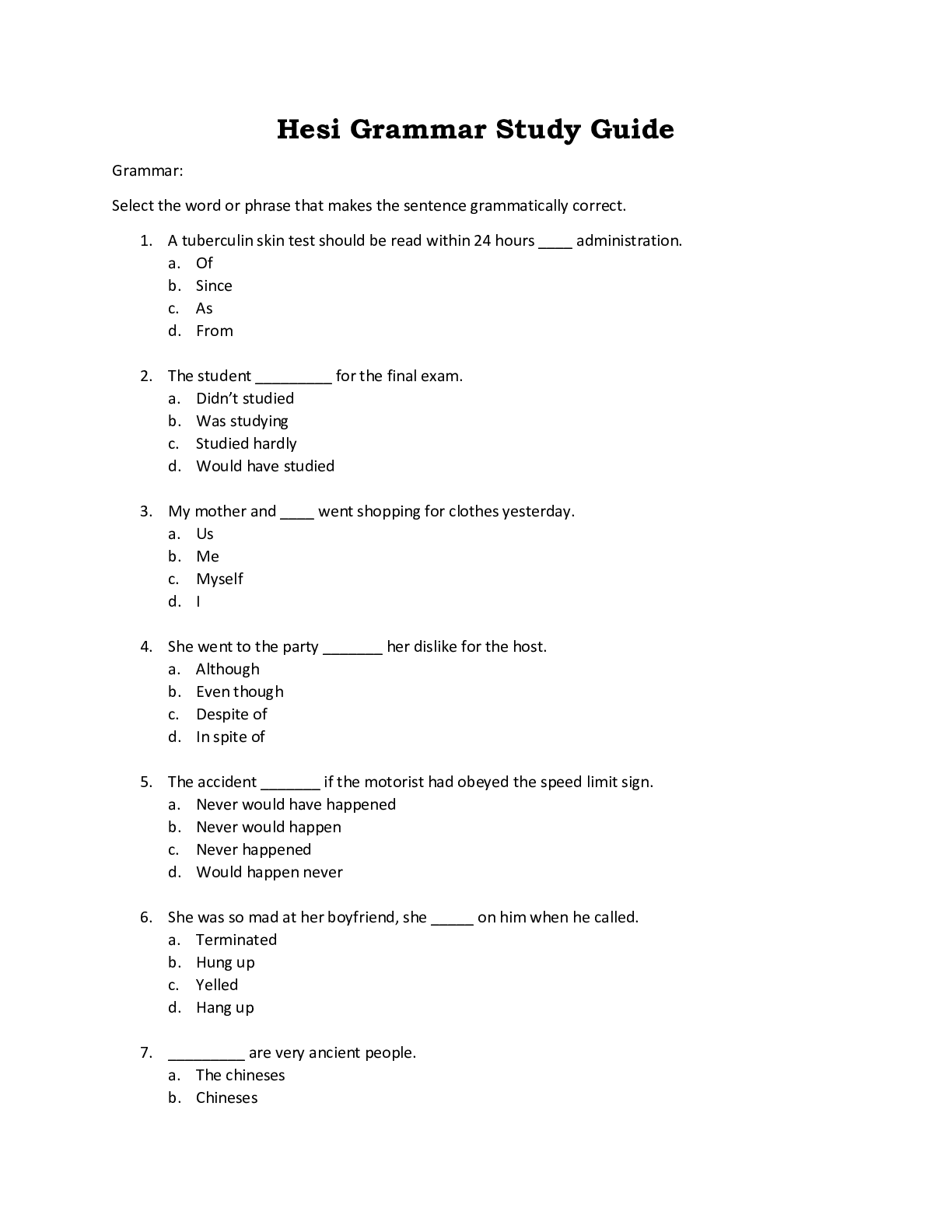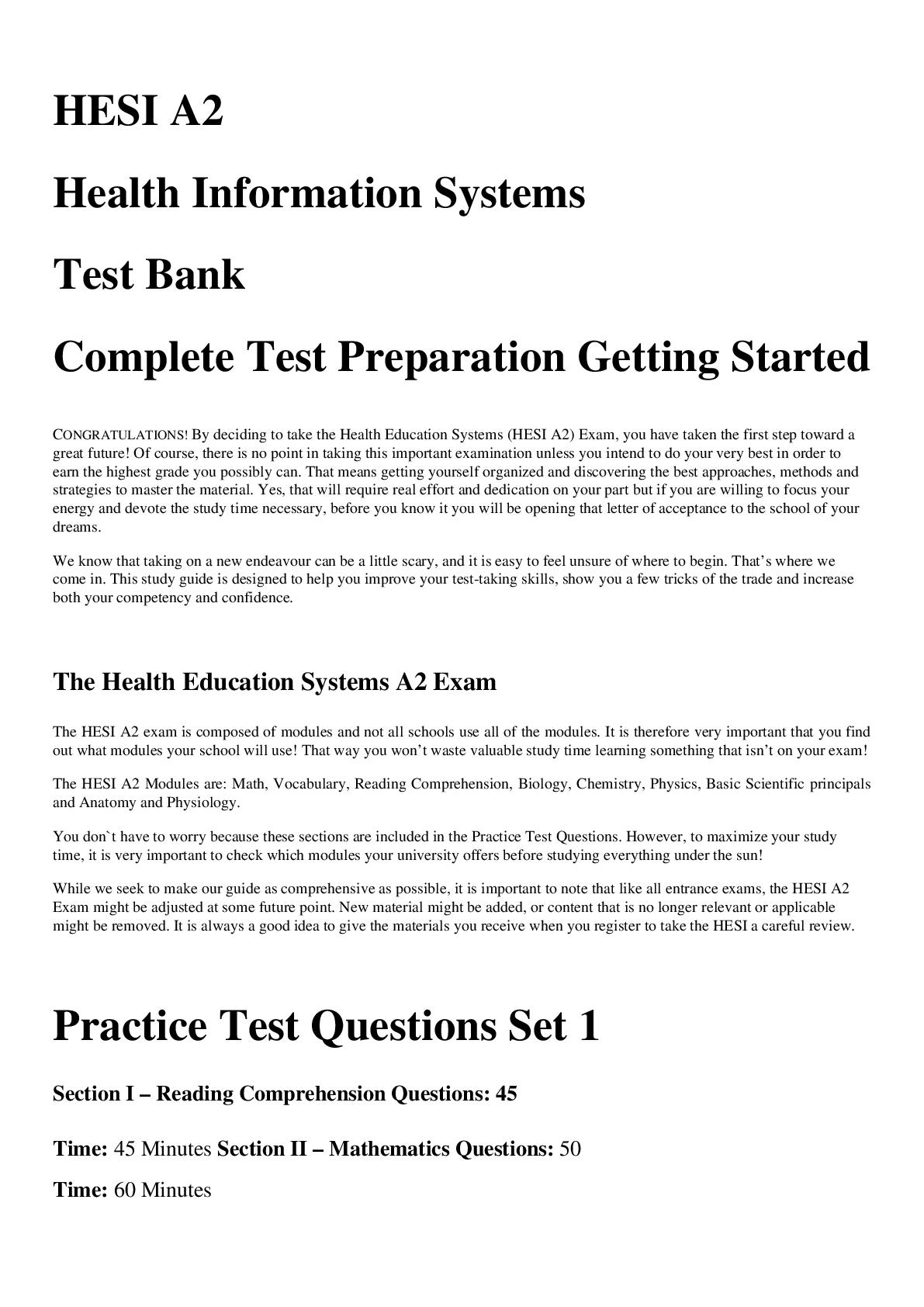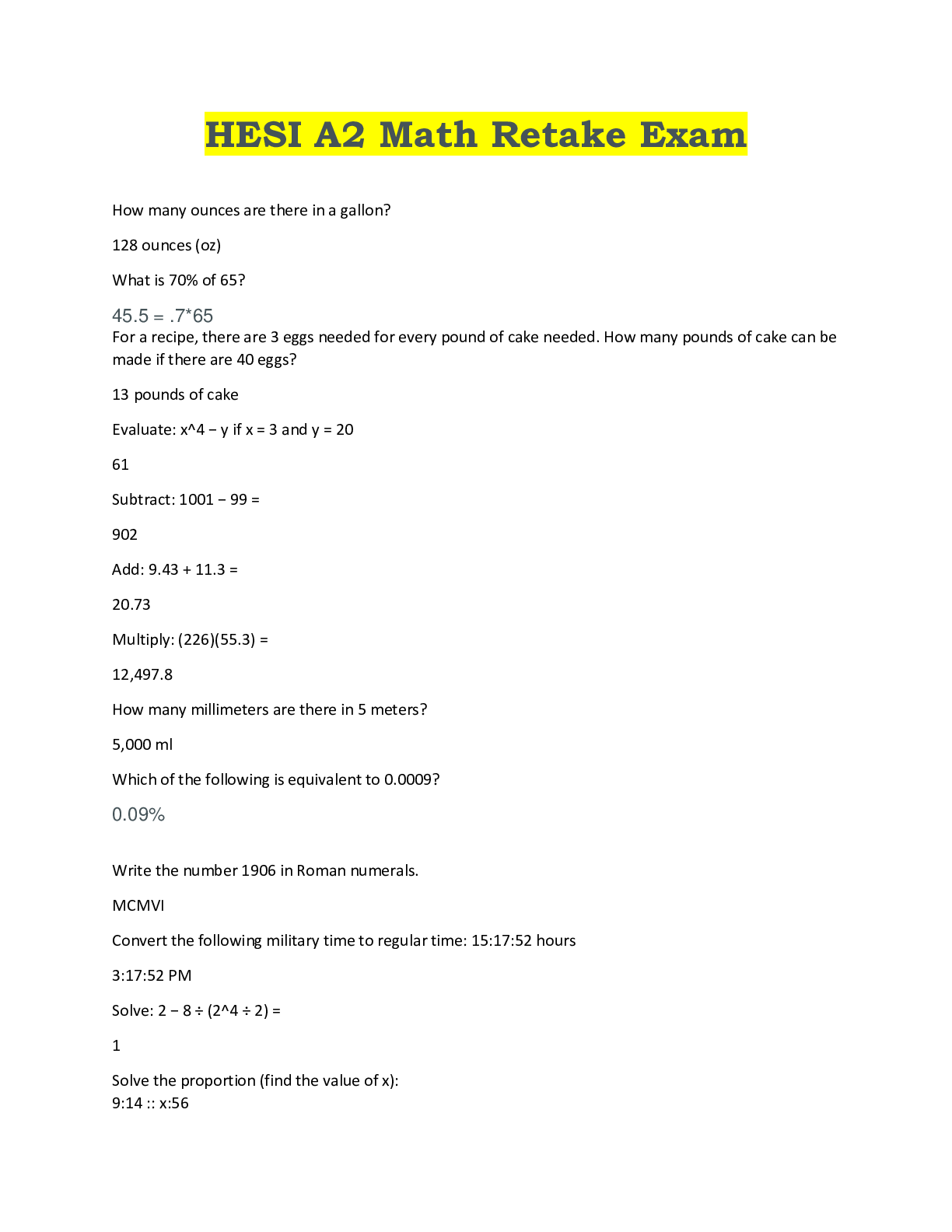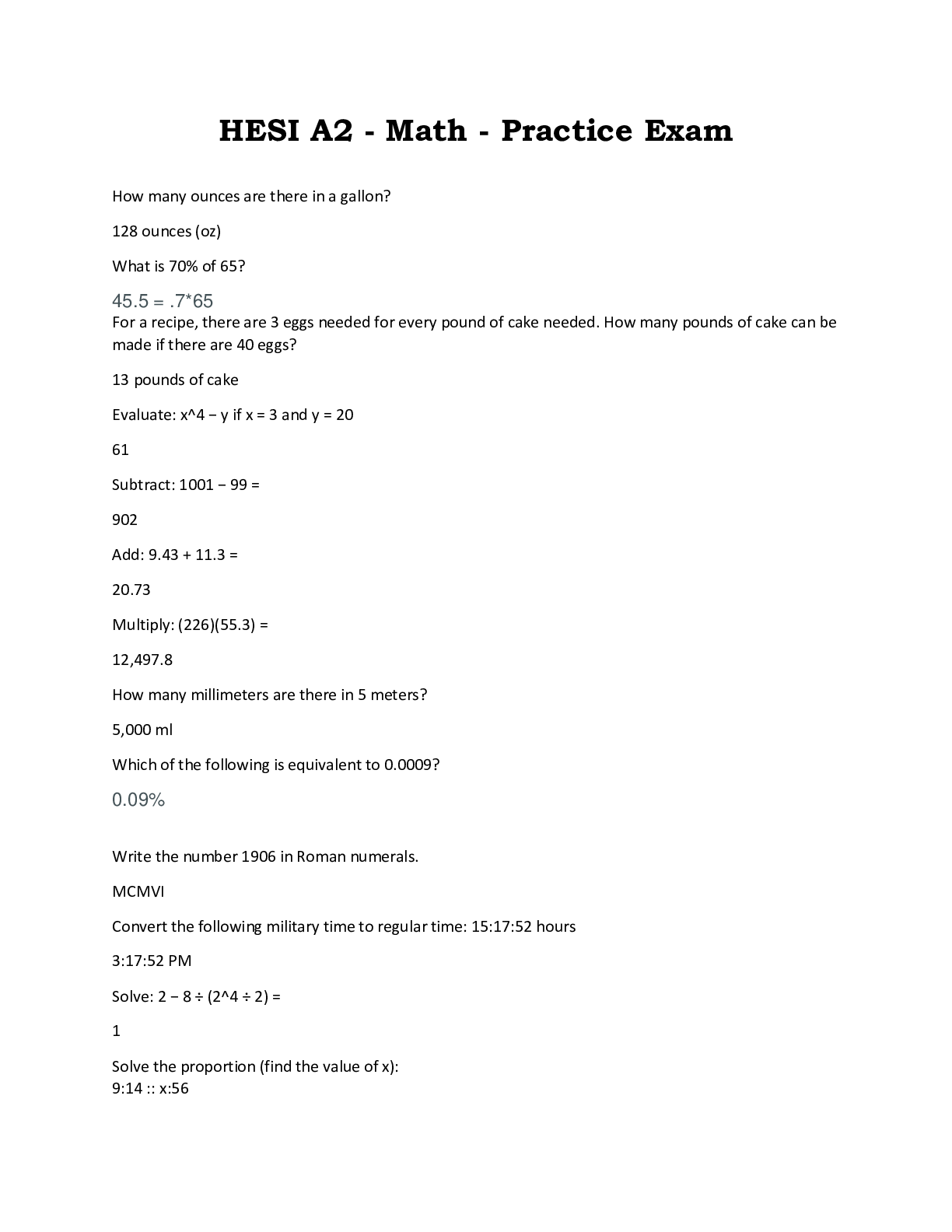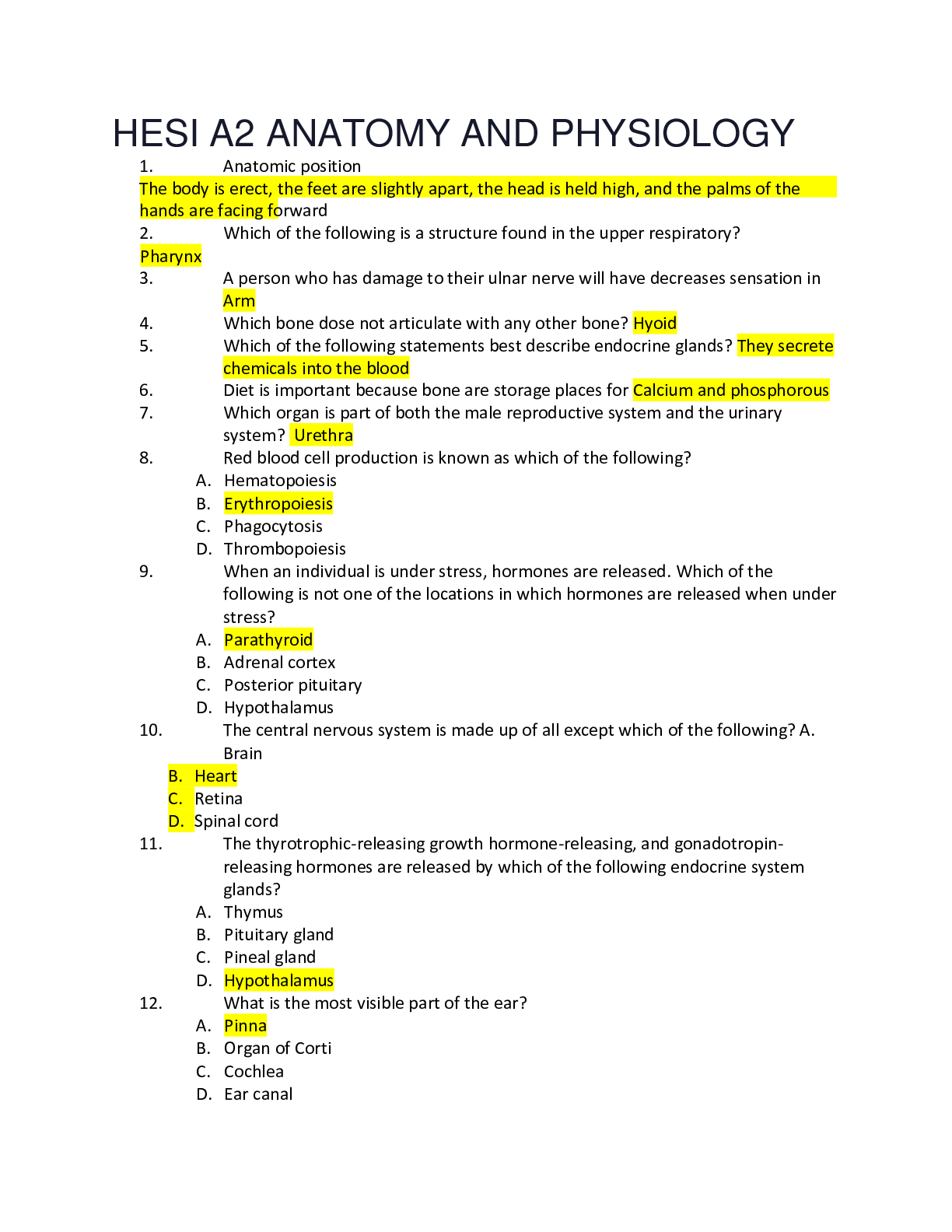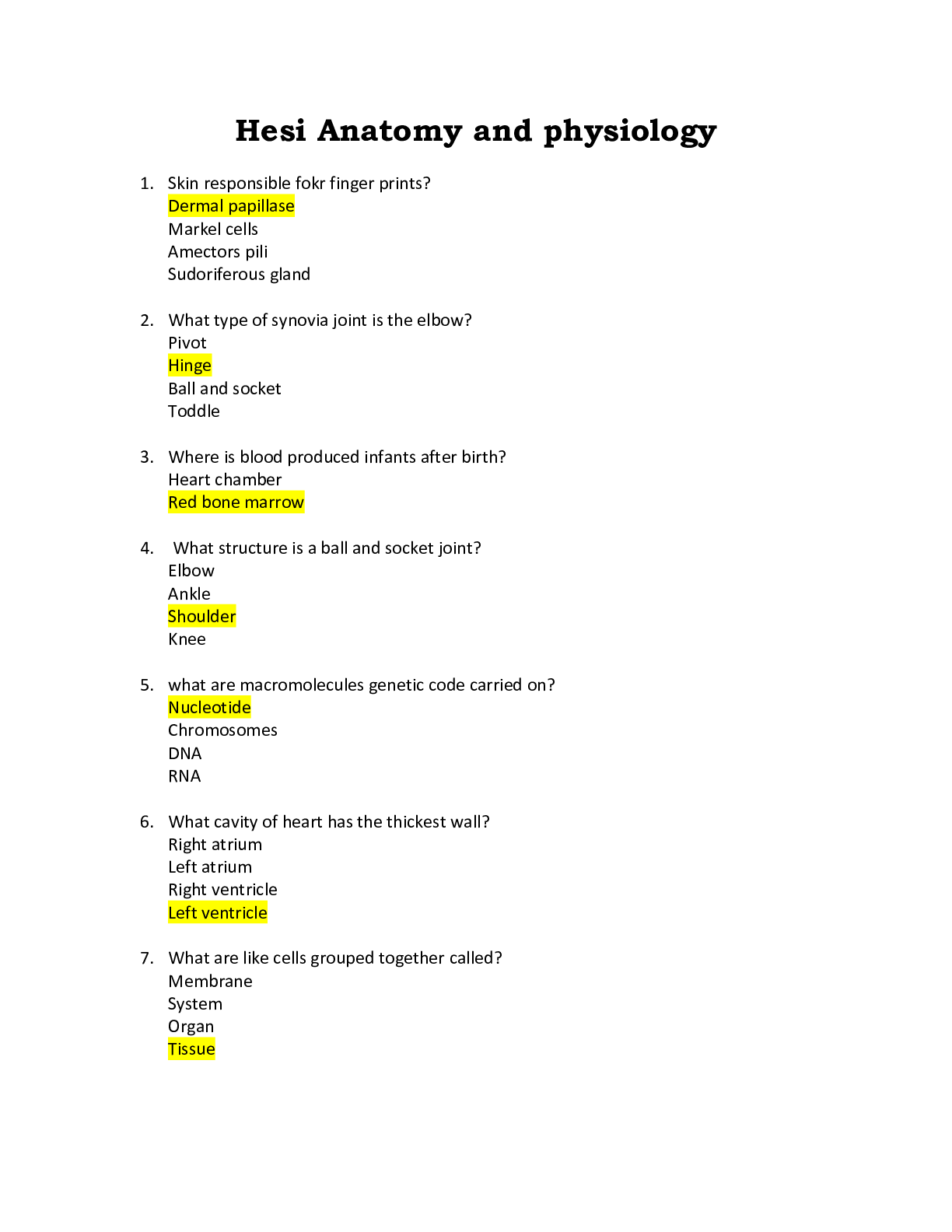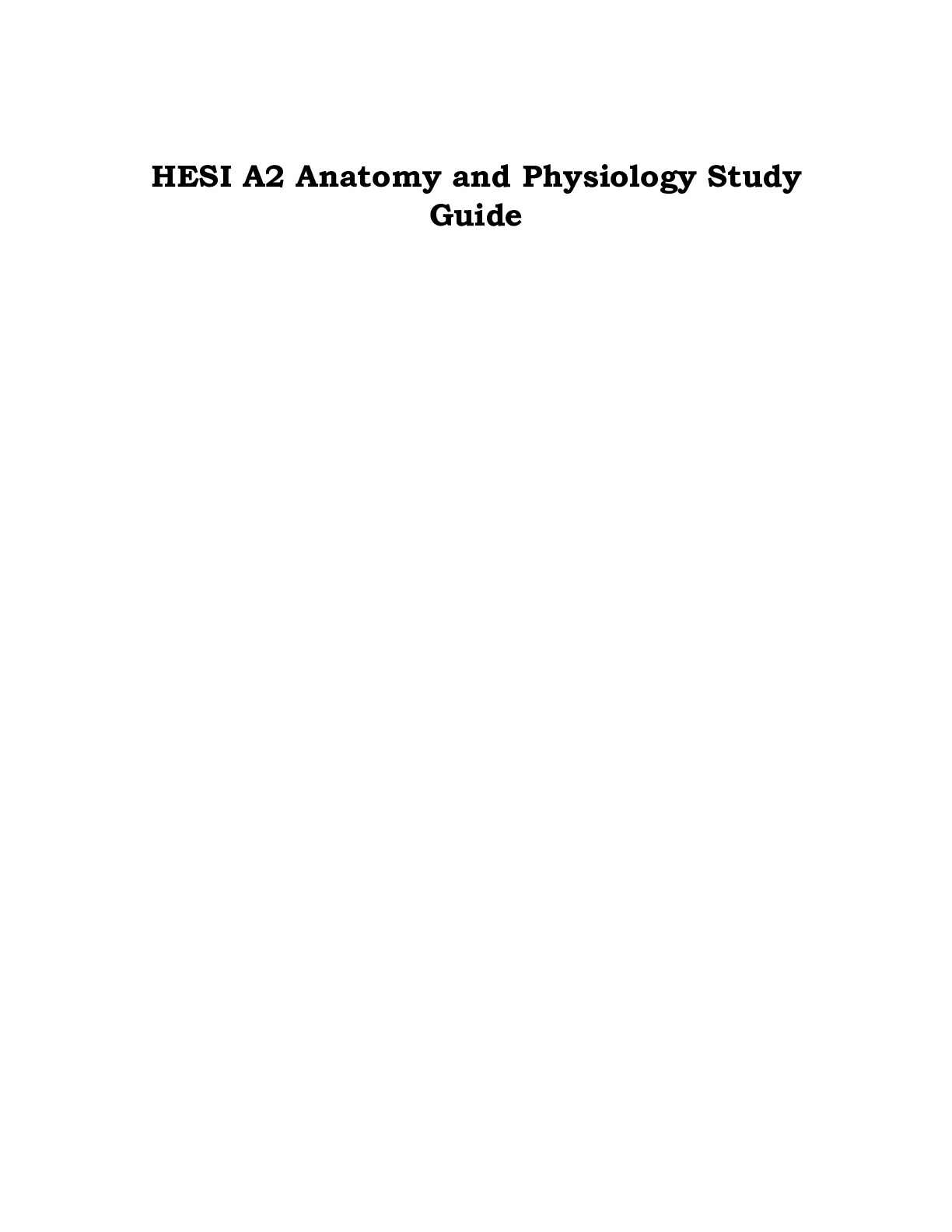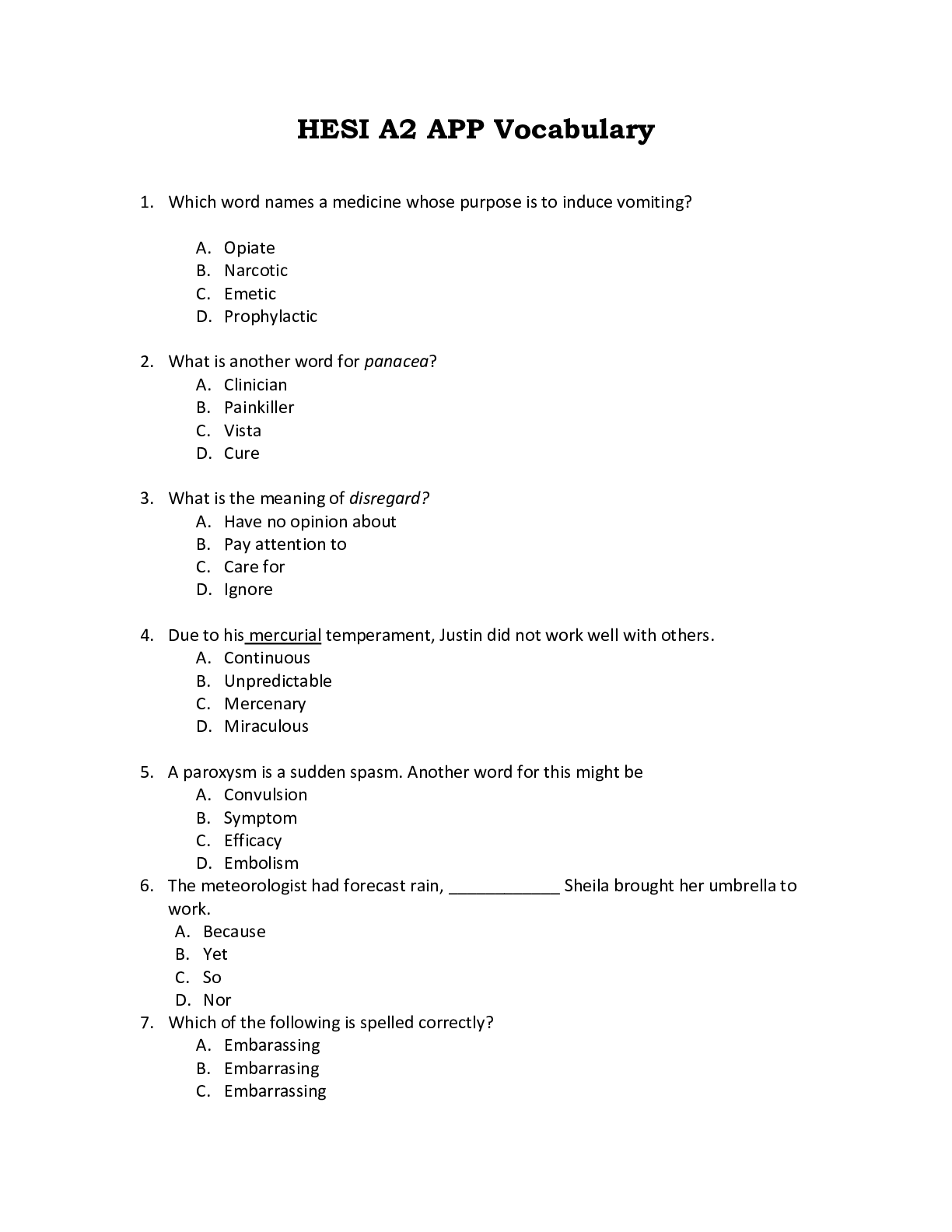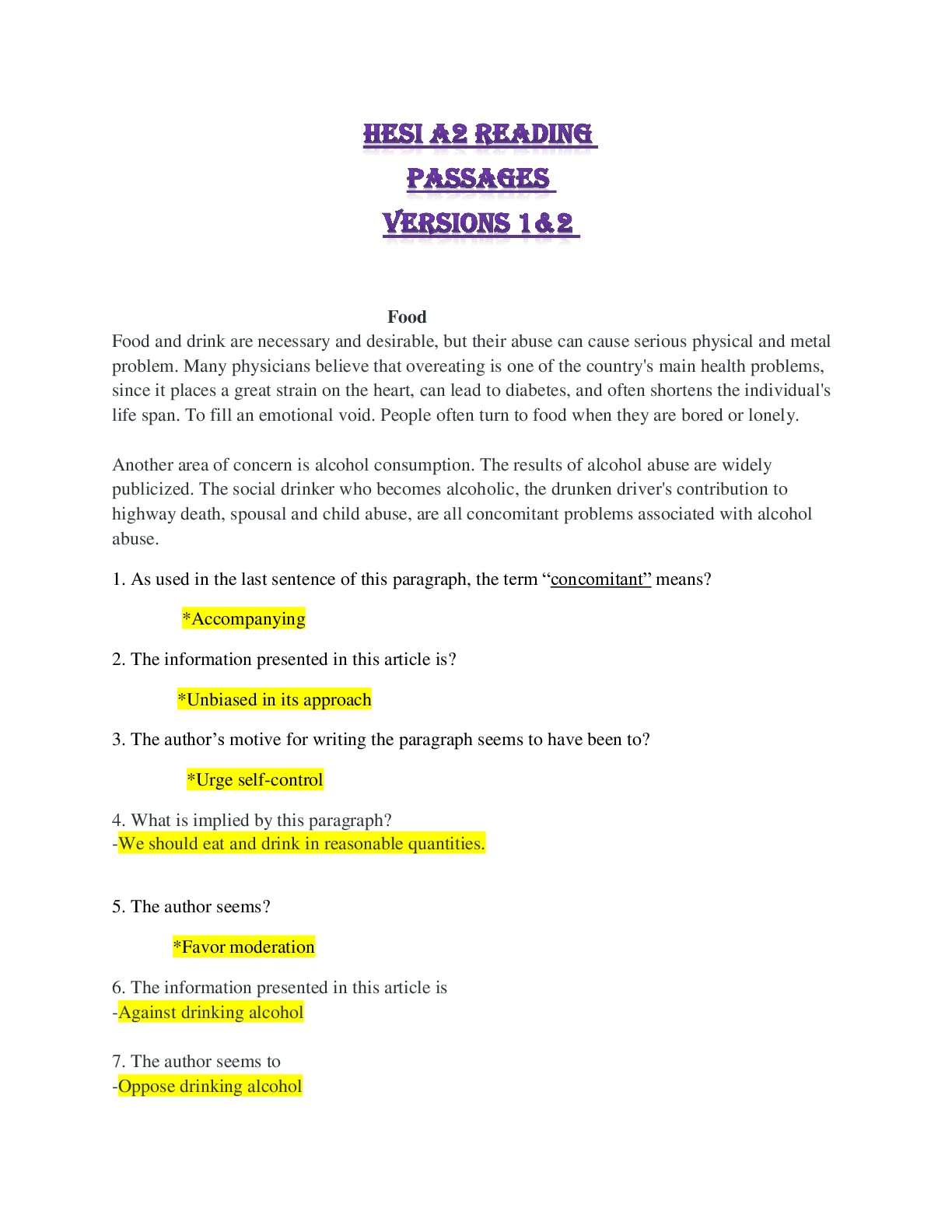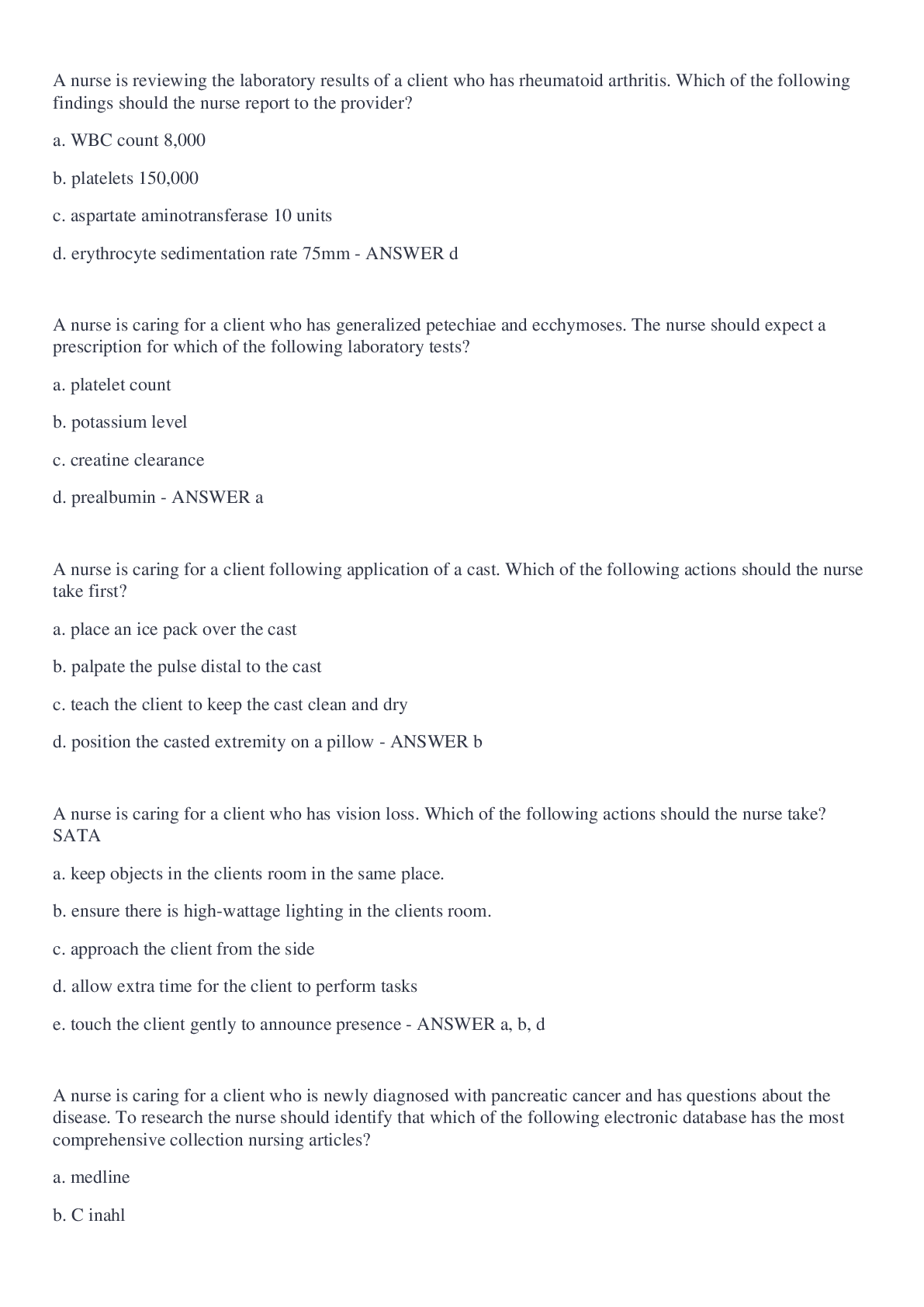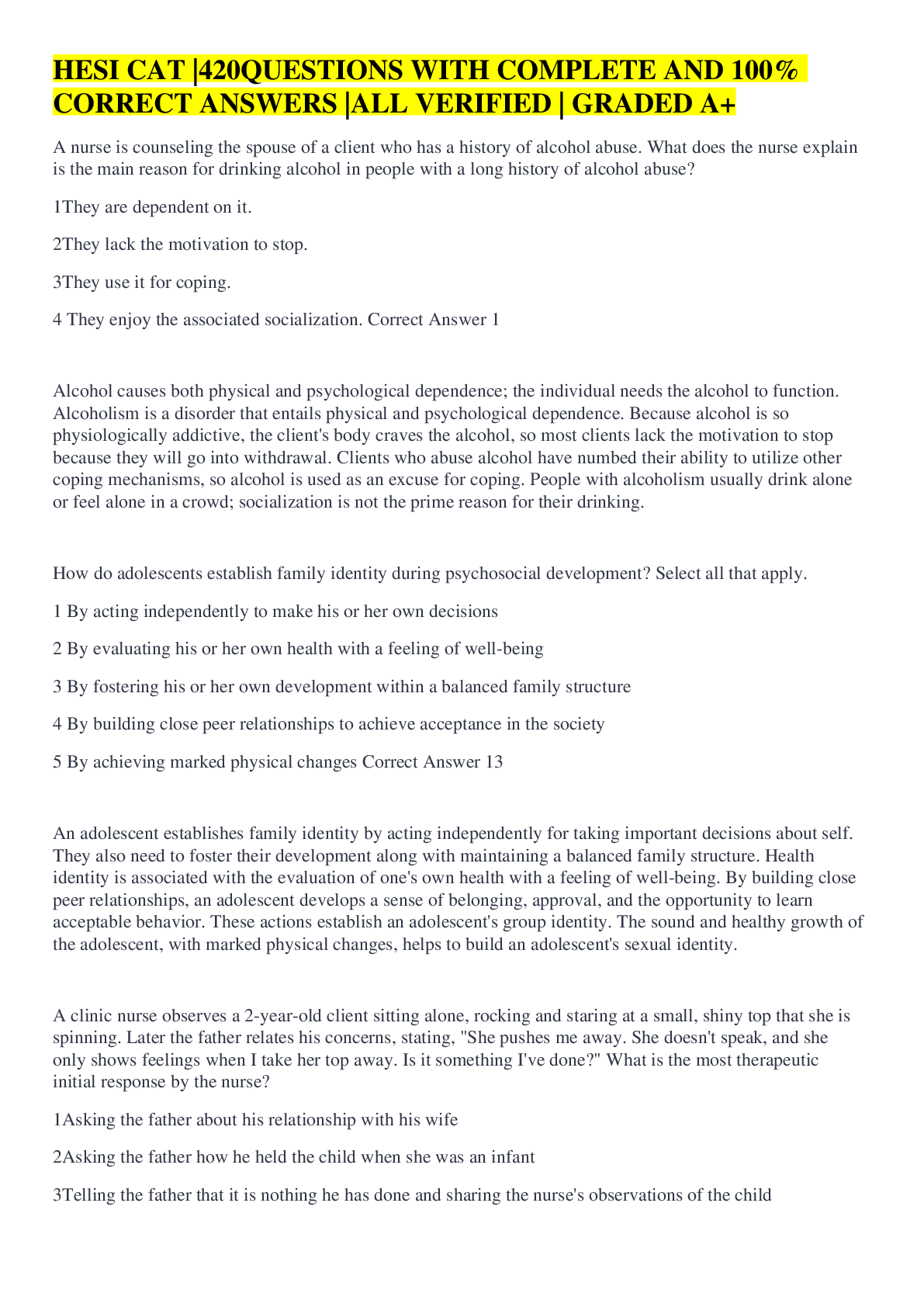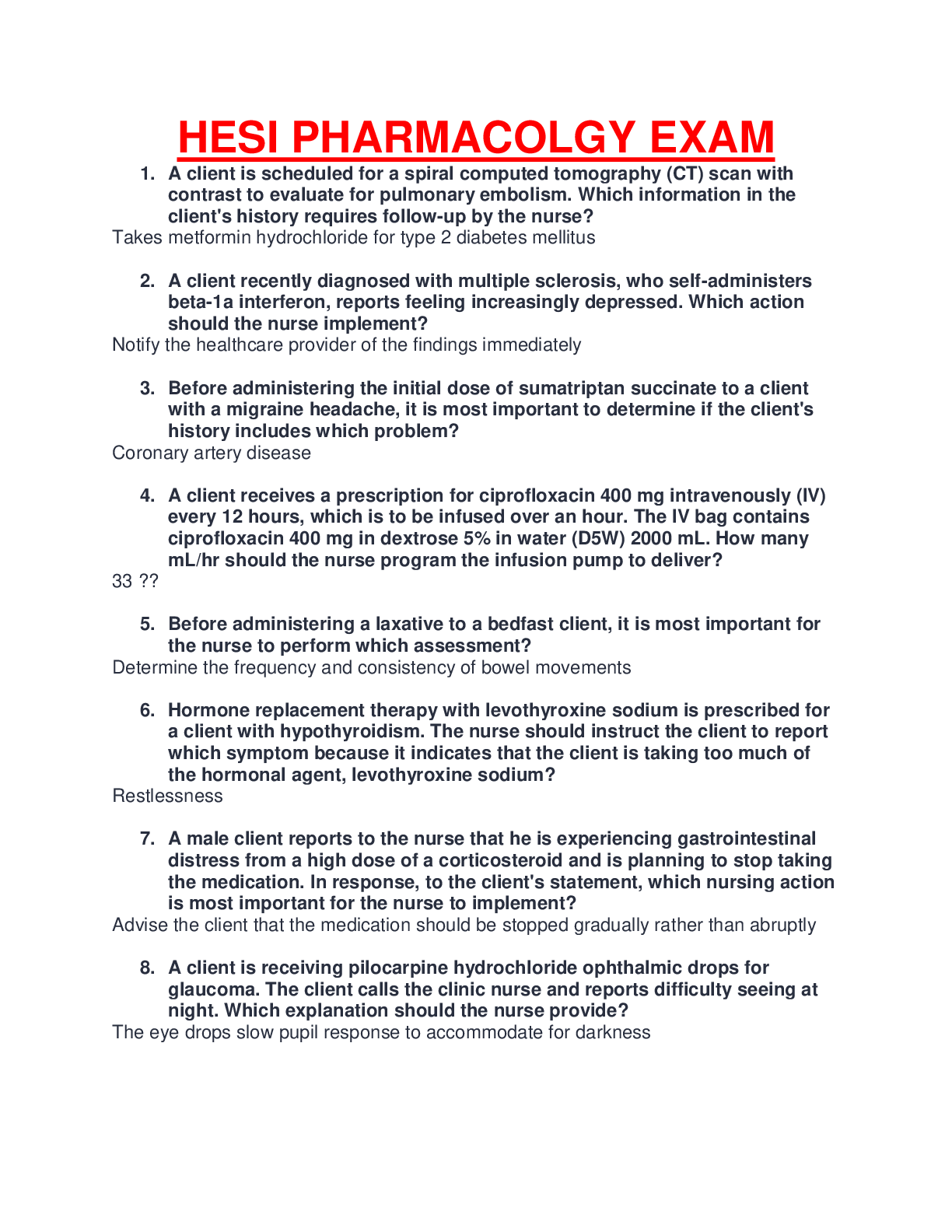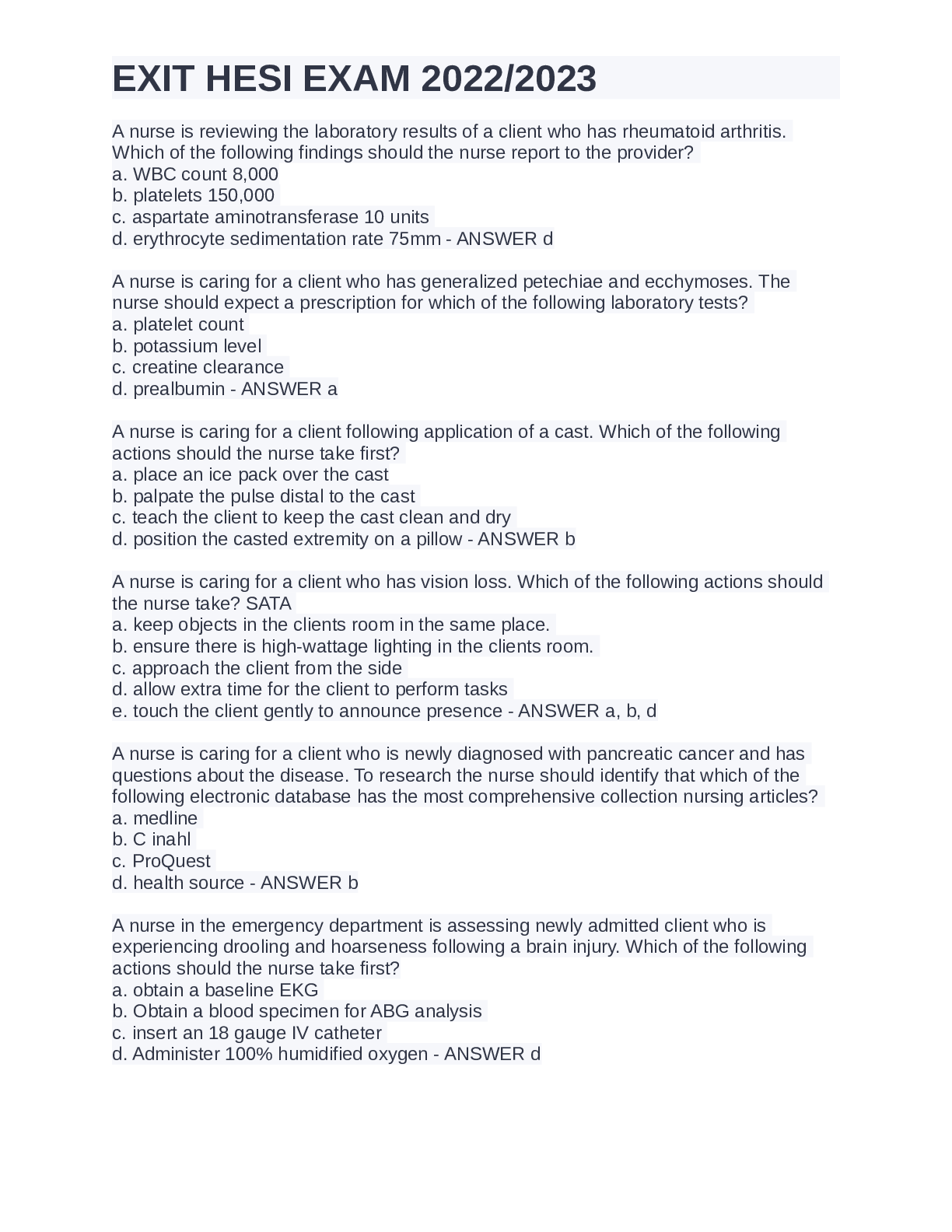HESI ANATOMY AND PHYSIOLOGY v3 for 2022/2023 COMPLETED A
Document Content and Description Below
HESI ANATOMY AND PHYSIOLOGY 30 questions that I did! 1. The pulse point located behind the knee is palpated over which artery? Popliteal 2. Part of the body Facing forward- Anterior 3. ……ABCD ... of cancer? Melanoma {The most dangerous form of skin cancer} 4. Which of the following statements best describe endocrine glands? They secrete chemicals into the blood 5. Which organ is part of both the male reproductive system & the urinary system? Urethra 6. Anaerobic respiration can lead to a burning sensation caused by which molecule? Lactic acid 7. When assessing a female client who describes herself as a vegetarian in the nurse notes that she has an unusual skin color. The nurse should ask the client if she has eaten large amount of: carrot and squash 8. Which hand position describes an anatomical position of a person who is standing erect with feet forward? Palms of the hand facing anteriorly 9. What are like cells grouped together called? A tissue 10. What type of synovial joint is the elbow? Hinge 11. Which structure is a ball and socket joint? Shoulder 12. What are fingerprints made of? Friction Ridges 13. What are like cells grouped together called? Tissue 14. Which is the largest chamber of the heart? Left Ventricle 15. Membrane that lines body cavities that open the exterior of the body is mucous membrane (inside of the body cavity- serous membrane) 16. Which muscle of the quadriceps femoris group lies on the slide surface of the lower extremity? Vastus lateralis 17. Which structure is located on the sternum? Xiphoid process 18. What occurs when the sympathetic nervous system is stimulated? Increased Cardiac output 19. Where does digestion begin in the digestive system? Oral cavity/Mouth 20. Which cell structure regulates the transportation of substances in and out the cell? Cell membrane 21. The Malleus, Incus, and Stapes are located in which part of the body? Ear 22. What is the function of the thrombocytes (platelets)? Play role in blood clotting 23. What is the response of cells in the collecting tubules in the nephrons when antidiuretic hormone (ADH) is secreted? Water is reabsorbed from the urinary filtrate 24. What is the function of Golgi body/apparatus in the human cell? Process protein secretion. synthesize carbs and glycoproteins 25. 4 steps in Bone formation: Hematoma (inflammation)-callus formation-ossificationremodeling. 26. Which lobe of the brain is responsible for auditory functioning? Temporal lobe 27. When water molecules move across cell membrane from high to low concentration this process is called? Osmosis 28. Facilitates the recognition of genetic code on macromolecules? DNA 29. What plane divides the body from left to right? Sagittal plane 30. Aqueous humor is watery fluid in which part of the body? EyeA&P version 1 and 2 1. What are the chemical substances that prevent a sharp change in the pH of a fluid when an acid or a base is added to it? Buffer 2. What do T-lymphocytes do? Defend the body against microbes 3. Which structure produces T-lymphocytes? Thymus 4. Which structure produces B-lymphocytes? Red bone marrow 5. What is the function of Eustachian tube? Equilibrates pressure between the middle ear and external environment 6. What physiological response occurs when epinephrine and non-ephedrine- Blood is directed toward the heart, skeletal muscles and brain. 7. Which of the following is a structure found in the upper respiratory system? Pharynx(throat). It includes nose (nostrils), nasal cavity, mouth, and larynx (voice box). The structure in the lower RS includes: Trachea, primary bronchi and lungs. 8. Calcaneus is located in what part of the body? Foot 9. Dorsiflexion plantar flexion are types of joint movement that are associated with which part of the body? Foot 10. A person who has damage to their ulnar nerve will have decreased sensation in which area? Arm – inability to abduct hands and fingers 11. The ankle is distal to the knee 12. Posterior means what part of the body? The back 13. Which bones are located in the forearm? Ulna and Radius 14. Which bone dose not articulate with any other bone? Hyoid – is a U-shape bone in the neck that supports the tongue 15. Which of the following elements is necessary for muscle contraction? Calcium 16. Diet is important because bone are storage places for? Calcium and phosphorous 17. What female reproductive organ produces oocytes, estrogen, progesterone? Ovaries 18. Which layer of the cutaneous membrane are nerve ending located- Dermis {Where is the nerve ending close to the skin? Dermis} 19. Which bones are formed first by intramembrous ossification? Flat bones of skull 20. Ligaments provides with connection? Bone to bone (Tendon -muscle to bone) 21. Sprain occurs when there is a tear in which structure? Ligament muscle/ankle/shoulder 22. Why are tendons and ligament most likely to be slow in healing following an injury? Lack of blood supply/because these connective tissues are avascular. 23. Compact tissue with Haversian canals is classified as what type of tissue? Bone 24. What structure conducts urine from the kidney to the urinary bladder? (The tube between kidney and urinary bladder) Ureter 25. As part of the negative feedback system, which type of cell is stimulated to resorb bone matrix in response to a decrease in calcium in the blood? Osteoclasts 26. Sweat on the skin's surface cools the body through which process? Evaporation 27. A Client has large pituitary tumor. The nurse knows that this tumor exists in which part of the body? Head /Client has large pituitary tumor what part of the body does this effect? Head hurt, sickness, low blood pressure 28. Which anatomical structure houses the malleus, incus, and stapes? Skull ear 29. Ceruminous glands secrete Ear wax/ Cerumen30. What is the function of the Sebaceous gland? To produce sebum or oil 31. The nurse explains to a client that the stomach is lined by which type of membrane? Mucous {The respiratory system is lined with a mucous membrane that secret mucus} 32. The mediastinum is located within which cavity? Thoracic 33. What effects do serotonin has on neurotransmitters? Involved with mood, sleep, appetite and anxiety 34. What does antidiuretic hormone act on? helps to control blood pressure by acting on the kidneys and the blood vessels. /Regulates and balances the amount of water in the body 35. The occipital region is located in which part of the body? Head (at the back)/ lower part of the cranium 36. In white blood cells what contributes to phagocytosis? Macrophages, neutrophils 37. Thrombocytes (platelets) smallest type of blood cell important for blood clotting. When bleeding occurs it swell, clump together and form sticky plug that helps stop the bleeding. 38. Which blood element carries oxygen- Erythrocytes (Red blood cells) 39. Which structure carries oxygen to the cells? Hemoglobin 40. Blood cell formation – Hemopoiesis {Blood cells is also called hematopoietic cell, hemocyte or hematocyte. The three main types of blood cells are Platelets (thrombocytes), Red blood cells (erythrocytes) and White blood cells (leukocytes) - basophil, neutrophil, eosinophil, lymphocytes and monocytes}. 41. Which gland is commonly known as the "Master Gland"? Pituitary Gland 42. What epidermal derivative is involved in temperature homeostasis? Eccrine gland- regulates temperature 43. Which statement are true about bone? Osteoblast, epiphyseal, diaphysis. 44. What internal structure of the ear is concerned with hearing? Cochlea 45. Which structure of the gastrointestinal tract controls the movement of content from small intestine to the large intestine? Ileocecal valve 46. What are the divisional regions of the large intestine (colon)? Cecum, transverse colon, sigmoid colon. (cecum-ascending-transverse-descending-sigmoid colons) 47. Where in the human body are nutrients absorbed? Small intestine (Small intestine is made up of three segment – Duodenum, Jejunum, and ileum). 48. Ossification begins during what? Embryonic development 49. Fertilization occurs in the? Oviduct 50. Fertilization of an ovum occurs in which anatomical structure? Fallopian tubes 51. Which term is used to describe the waist bones/area? Carpal 52. An over-production of cerumen (earwax) can accumulate in which area? External ear canals 53. The mitral value is located between which two structures? Left ventricle & Left atrium (Tricuspid – right ventricle and right atrium) 54. The olfactory nerves are associate in which sense? Smell 55. Which of the special senses respond to chemical? Taste and olfaction 56. Which vessel brings blood from the lungs to the heart? Pulmonary vein 57. What vessel carries blood from the body to the heart? Vena cava58. Which hormone(s) is/are produced by the ovaries? Estrogen & progesterone (Men – Estrogen and testosterone) 59. Two principles divisions that makeup nervous system? Central Nervous System (CNS) and Peripheral Nervous System (PNS) 60. The orthopedic surgeon informs you that you have broken the distal region of the humerus. What area is he describing? Epiphysis 61. Which term is used to describe movement of the arms and legs away from midline of the body? Abduction- arm away from the body (Adduction- arm towards the body’s midline) 62. Which part of the body do you check for carotid pulse- Carotid Artery. Structure provides a pulse reading in the neck? Carotid Artery 63. What is the primary function of the hemoglobin (blood)? Carry oxygen 64. What stimulates the chemoreceptors to function? rise in CO2; Fall in O2 (increase in blood pressure) 65. Which condition causes a client to say "I can't see far away"? Nearsightedness 66. What organ produces insulin? Pancreas 67. When drawing blood from antecubital region which blood vessel is used to obtain blood? a) Ulnar vein b) Radial artery c) Axillary artery d) Brachial vein (Median cubital) 68. What hormone induces growth of pubic and axillary hair at puberty? Testosterone and estrogen 69. Increase in rate of depth of breath results in what blood PH change? Alkalosis 70. What is the function of the hypothalamus? (Regulate body temperature) Regulate function of body, balance and thermoregulatory 71. The passive movement of molecules or particles along a concentrated gradient or from a region of higher concentration to a lower concentration is called Diffusion / Filtration is the process by which water and solutes are forced through a membrane or capillary wall by fluid or hydrostatic pressure 72. Transverse plane is a cross section of the body. Coronal – separates back and front} 73. What part of the body is the lower back? Lumbar vertebrae 74. High levels of which ion would most likely result in a cardiac arrest? Potassium 75. What blood vessel perfuses the kidney? Renal vein 76. The skin is the largest organ of the body. What gives the skin its color? Melanin 77. What is the outer most protective layer of the skin? Epidermis (the inner layer of the skin is dermis- composed of fibrous connective tissue with blood vessels, sensory nerve endings, hair follicles and glands) 78. The organ of corti is located in? Ear 79. The rough endoplasmic reticulum functions in the human cell to? Synthesize proteins Function of rough ER- protein synthesis, membrane production. Smooth ER synthesize lipids and steroids, regulate calcium concentration 80. Tissue repair is enhanced by a diet high in? Protein 81. What is the definition of chyme? partly digested food! The result of action by the stomach. (the thick, wet mass of partly digested food that leaves the stomach) 82. What are hormones? chemical messengers secreted by endocrine glands that controls or coordinates the activities of other tissues.83. What cellular process helps to move debris and mucous through the lining of tubules? Cilia (An epithelial cell that other goes circle of movement is cilia) 84. Which is a hollow organ? Gall bladder (heart, stomach) 85. Which muscle is included in the quadriceps femoris group? Rectus femoris, Vastus lateralis, Vastus medialis, Vastus intermedius 86. Which of the following location would the urinary bladder & internal reproductive organ be found? Pelvic region/cavity 87. Which part of the brain attaches to spinal cord? Medulla oblongata 88. Which structure is responsible for normal respiratory function? Medulla oblongata – it controls breathing Cerebrum – associated with movement and sensory input Cerebellum- responsible for muscle / muscular co-ordination Medulla oblongata- controls many vital functions such as respiration and heartbeat/rate 89. T4 is controlled by what? Thyroid 90. What gland is located on the anterior surface of the trachea? Thyroid Gland 91. Function of ADH - reabsorption of water 92. Which hormone is produced by the posterior pituitary gland? ADH and Oxytocin 93. Which hormone is produced by the anterior pituitary gland? Follicle stimulating hormone (FSH) {also includes – TSH, LH, ACTH, Growth Hormone and PRL} 94. What female hormone stimulate the development of Graafian follicles? FSH 95. What occurs when the sympathetic nervous system is stimulation is increased? Blood pressure rises, goose bumps 96. What part of the body is the buttock- dorsal. / The buttock is on which surface of the body? posterior body surface 97. The esophagus is located in which body cavity? Thoracic 98. The tympanic membrane is located between which structures? External auditory canal and middle ear (tympanic membrane -ear drum, it is a thin membrane that separates the outer (external) ear from the middle ear) 99. What is the end result of meiosis? 23 chromosomes {Mitosis – cell division that produces two identical daughters (process in which DNA is duplicated); Mitosis is necessary for growth and repair/ Meiosis - cell division that takes place in the gonads (the ovaries and testes), chromosomes number reduces from 4623}. 100. How many days is the average menstrual cycle? 28 days 101. Urinary system in the human body primary task is to? Expel waste 102. What is the function of the phrenic nerve? Innervates the diaphragm The phrenic nerve (cervical plexus) is a nerve that originates in the neck (C3-C5) and passes down between the lung and the heart to reach the diaphragm. It is important for breathing, as it passes motor information to the diaphragm and receives sensory information from it, there are two phrenic nerves, a left and a right one. 103. What does vitamin D do to the skin? Vitamin D contributes to skin cell growth, repair, and metabolism. It optimizes the skin’s immune system and help destroy free radicals that can cause premature aging. Vitamin D regulates two important bone materials- calcium and phosphorous, which stimulates internal absorption of Ca and P to maintain healthy blood levels and build and maintain bone. Biological function of vitamin D- calcium balance, immunomodulation, regulate cell-growth, and reduces hypertension by downregulating renin production.104. Which of the following produce progesterone to prepare the uterus for pregnancy? Corpus luteum 105. Which antibodies are found in the plasma of type A blood? Anti B 106. Which antibodies are found in the plasma of type AB blood? Neither A or B 107. What encloses the heart? Pericardium 108. Where is the tibialis anterior muscle located? Lower leg (Largest bone of the leg- Tibia, smallest bone of the leg- Fibula) 109. How many carb per gram do carbohydrates contain? 4 110. Where is the pulmonary ossification center located? Diaphysis 111. Which of the following best describes a capillary? Location for gas and nutrient exchange (nutrients and gas exchange occur in the capillaries, not veins or arteries) 112. Which one increases angle at the joint? Extensor 113. What are the four basic tissue types? Connective, Epithelium, Nervous, Muscle. 114. Order of organization of living things: Organelle, cells, tissues, organs, organ systems, organisms, populations, communities, ecosystem, and biosphere 115. What is the function of aldosterone in the kidneys, when it is secreted? It conserves sodium in the body 116. What does lymphatic system do? Filter lymph, remove debris. Function of lymph nodes- They filter lymph and assist the immune system in building an immune response. Lymph is a clear fluid that comes from blood plasma and exits blood vessels at capillary beds. 117. What structure of the eye picks out color? Retina 118. What is the transparent portion of the fibrous layer of the eye? Cornea 119. The basic unit of life and the building block of tissue/organism- Cell 120. The study of tissues/cells - Histology 121. What characteristic best describe dermis? Structure and strength 122. Osteoblast – cells that form compact bone 123. Broken humerus adolescent: classified as a proximal fracture or a shaft fracture. 124. The enzymes that regulates all chemical reactions within the body - Proteins 125. Hormones are chemical messengers that control the growth, differentiation, and metabolism of specific target cells. Two types- Steroid hormone and Protein hormone The main production of endocrine gland is hormones 126. Causes of ear infection in children? It is the length of the Eustachian tube. (Kids have shorter Eustachian tube). 127. Herpes is a viral infection usually characterized by? Skin eruption / Sign of Herpes? Rash 128. Function of trachea, bronchi, and bronchioles? Warm and moisten air before it enters the lungs 129. Which subdivision of autonomic nervous system operates using the neurotransmitters norepinephrine and epinephrine? Sympathetic Nervous System 130. Sensory neurons (afferent) transmit nerve impulses toward the CNS {spinal cord and brain}, Motor (efferent) neurons transmit nerve impulses away from d CNS towards the organs such as muscles, glands, &digestive organs. PNS- all other neurons in d body.131. Axons transmit the impulse away from the cell body, while dendrites transmit the impulse towards the cell body. 132. What part of the male reproduction produce most of the semen? Seminal Vesicle 133. Produce most of the sperm- Seminiferous Tubules 134. It is very cold… shivering? What muscle is involved? Skeletal muscle [Show More]
Last updated: 1 year ago
Preview 1 out of 7 pages
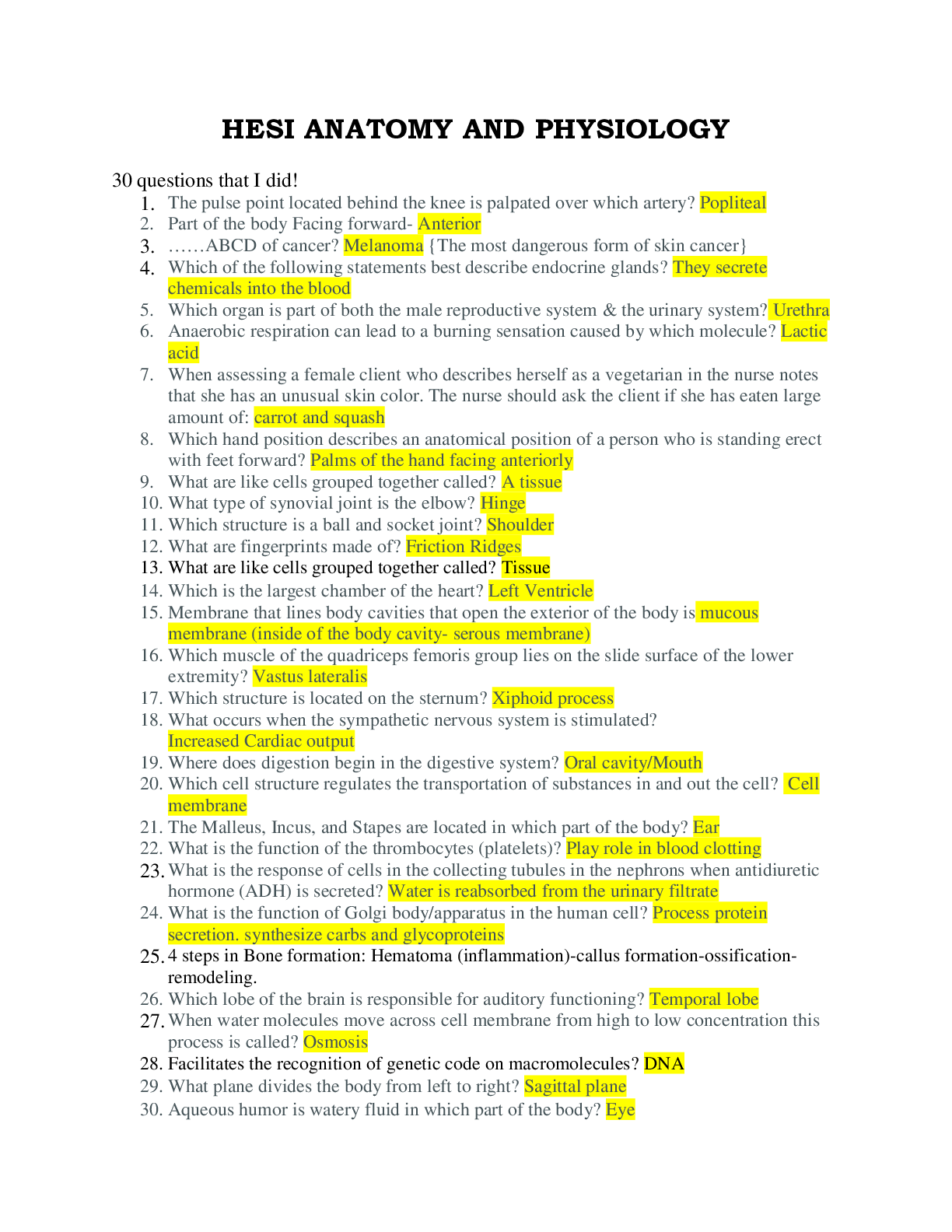
Reviews( 0 )
Document information
Connected school, study & course
About the document
Uploaded On
Jan 27, 2021
Number of pages
7
Written in
Additional information
This document has been written for:
Uploaded
Jan 27, 2021
Downloads
0
Views
76
